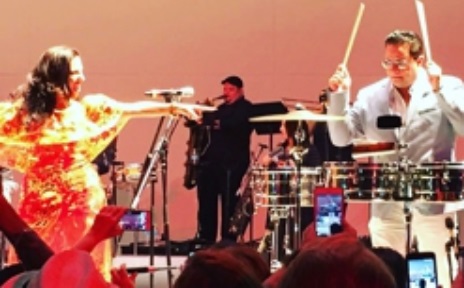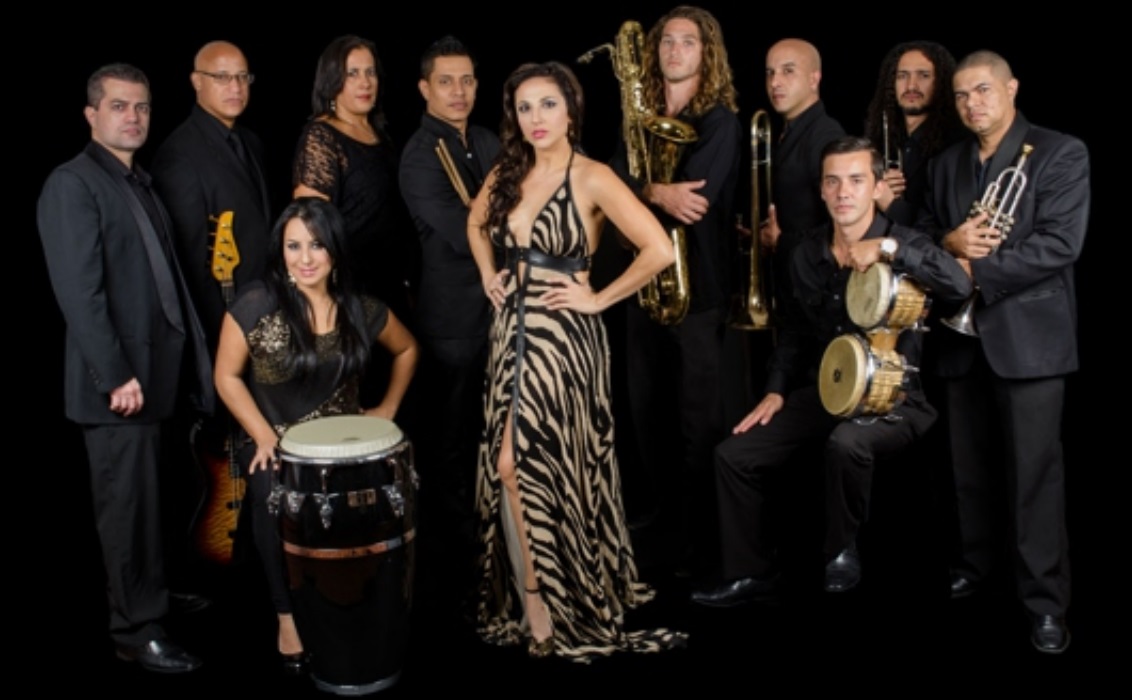North America / USA / New York
Melina Almodóvar

With an unwavering spirit, melodious voice, Caribbean cadence on her hips, friendly and cataloged by many as sexy, Melina Almodóvar has represented the Latin female son in the US. During her 20 years of artistic career, Melina Almodóvar has conquered audiences in the most imposing scenarios and has shared stages with the most recognized artists of the tropical genre
The nickname as many know she is “La Muñeca de la salsa” and which for a long period of time she sought to have because she had the same name that already identified another Salsa singer. Getting an ideal pseudonym to her was difficult, but not for a fan who, while delighting in her live presentation, cataloged her with this nickname with which they would later recognize her in the whole world.
“I wanted to give myself a nickname for Salsa … But I did not want to change my name … And then one day a gentleman says to me:” Hey, but you are a doll and look how you sing “, and then it was there that I stayed “La Muñeca de la Salsa”. It’s a name that stuck with me and it stayed there, so everyone knows who “La Muñeca de la Salsa” is and sometimes they do not know who Melina Almodóvar is, but I really like that name, I think it’s very beautiful”, she said.
At the age of 14, the interpreter born in San Juan de Puerto Rico lived an experience that marked her life since then. She moved with her mother to Memphis, Tennessee, leaving behind her culture and family, which caused an emotional shock and made her take full refuge in the music.

“Salsa saved my life.” The Salsa is my way of life. It’s my way of breathing, of doing things “.
“We moved to a very white place to an extremely American place. The south of the US is a very different place from New York or Florida. There are not many Latin people and for me it was very hard … I started studying music at the High School. I got into all the choirs that I could and all the bands in the school where I could be”, told me Melina.

This Puerto Rican composer not only prepared in salsa, also studied different musical styles: Blues, Jazz and Gospel. What made her race for only 3 years at the University of Memphis the career of Musical Execution. Studies that she decided to abandon for working at the same time as a receptionist and translator for the City Council and also to continue pursuing her dream of singing Salsa professionally. “I decided to quit my university studies because I was really doing what I wanted to do: that was to be a singer… I thought it was better to leave school and nothing has gone wrong, I have continued doing everything at that moment, but on a slightly larger scale and for me it was the right decision”, commented Amodóvar.
During the 90s, Melina and other music professionals created the first salsa orchestra in Memphis called “La Orquesta Caliente”. With this band toured places like Alanna, Kentucky and Alabama. They played at such iconic venues as Beale Street, one of the most famous music streets in all the US for almost 4 years, just as they did at Young Ave Deli, a place that filled to its maximum capacity just to hear them sing and play Salsa every Monday. In this regard, Melina told me: “That’s when I started singing Salsa. That’s when I fell in love with salsa and I wanted to continue being a professional Salsa singer.”


In 2003, she began her musical career as an independent soloist with her first album Rumba’s Salsa Soul Delight, where she exhibited her creative freedom to compose, work with other people in the music industry and create her own identity in this tropical genre. So, her second álbum was La Muñeca De La Salsa Y Más (2008) and Pasión y Salsa Live in 2013.
In all her productions this Puerto Rican singer based in Miami, likes to sing to the love in a very positive way. Each song is a tropical proposal of Latin culture, passion, celebration, dance and happiness that invites the dancer to enjoy. “I like to talk positively about things that make me happy. I do not like to shoot men … Because it’s not what happened to me. “She added: “I have a bolero that’s called Mi Nueva Página de Amor, but it’s very positive.

”Although the Salsa is a genre dominated by men, Melina has shown to take firm steps and open field solidly in the music industry, she has sung alongside major figures such as: The Great Combo of Puerto Rico, Andy Montanez, Bobby Cruz, Gilberto Santa Rosa, Marlo Rosa, Tito Puente Jr., el maestro Larry Harlow and Tromboranga.
She has developed a successful musical career of 20 uninterrupted years that has led her to perform at the biggest annual festivals and daily events in the country. For nine years “La Muñeca de la Salsa” performed live shows in South Florida at Tapas y Tintos club located in Miami’s South Beach with el maestro Ricky Torres, where thousands of dancers from all over the world gathered every Tuesday to dance and enjoy her music.

In 2010, Melina and approximately more than 600 dancers broke the Guinness Record for the largest number of people dancing Salsa at the same time a song. The idea got with her former manager Frank Nieves. The theme was “Lista pa’ Impresionar” of her authorship and doesn’t rule in the near future to do it again. “We were there seeing how we could do something different for an event that he was doing here for the Broward County Patron Festivities and we said why we did not try to break the Guinness Record. Establish a Guinness Record of the greatest number of dancers dancing a song and then we did it and it was spectacular”, said Melina.
In 2016, she released to the national and international market the salsa version single “Estoy aquí” of the popular Pop singer Shakira, whose arrangement was made by Seferino Cavan. The video of “Estoy Aquí” was shot on the famous beaches of Miami Beach and already has almost 1 million views.

Likewise, and in mid of 2017, Almodóvar recorded with Tito Puente Jr. a new version in Salsa Mambo of the song “Mi Socio” created by Tito Puente and Cuban singer La Lupe popularized in 1965. In the same way, she did with the singer and composer Bobby Cruz the song “La Chica del Bling”.
Currently, Melina does live performances every Friday to 6pm at Best Time Wine Shop located on 8th Street at 64th and 8th, a wine warehouse with a large dance floor. “Ándale! Pon a Sonar el Güiro” is her most recent single, it was released since last December and you can find it on all digital platforms. During this month of January, Melina will continue playing her music through the territory of Florida with the event Los Patrones de la Salsa and on April 7 she will produce along with her friend Kristina Moinelo the biggest salsa festival in Miami, the Hollywood Salsa Fest, in which she will also participate as a main star with great figures of salsa music.

Melina Almodóvar believes that the Salsa will never die because it is in the Latin idiosyncrasy and at some point this AfroCaribbean genre will return to be that people like most. She also commented that she does not rule out the possibility in the future to do a fusion with the new urban musical trends of the moment.
“For me to represent Latin music in the US is a very big honor because I love tropical music more than anything. It’s my life, it’s my way of breathing like all the SALSEROS … For me, it’s the whole world to be able to continue my long-standing career, to go ahead and bring good Salsa for the whole World.” Melina Almodóvar
The Salsa is the NUMBER ONE music genre that is danced around the world. I believe that we are keeping this genre alive with what we are doing every day. “Melina Almodóvar

To more information about La Muñeca de la Salsa, please visit www.melinaalmodovar.com or like her on Facebook: www.facebook.com/pg/MelinaSalsa















